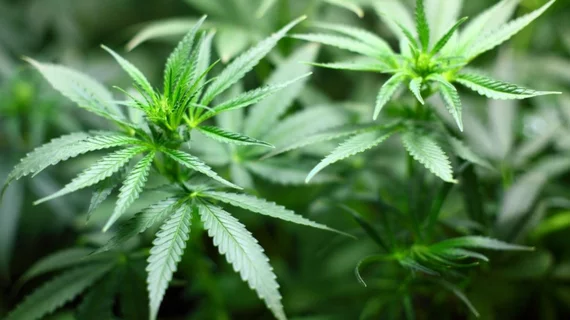Finding balance: What marijuana legalization means for heart patients
Canada legalized recreational cannabis countrywide Oct. 17, triggering a national response that’s resulted in near-depletion of the country’s legal marijuana supply. But, as Canadians begin to embrace the new policy, local physician Taylor Lougheed, MD, MSc, suggests heart patients might want to consider their cardiovascular health before lighting up.
Lougheed, whose resume is extensive and includes ongoing stints in family medicine, emergency and sports healthcare and cannabinoid research, is the lead physician at Cannabinoid Medical Clinic in Ottawa, Canada. His interest in palliative medicine steered his research toward ketamines, LSD and, eventually, cannabinoids.
“I started to see that there really was a lot of stigma surrounding this area, but there’s also a lot of merit,” he told Cardiovascular Business. “And we needed to start filling the gaps in our research knowledge, because a lot of patients would be benefitting from this.”
There’s growing interest in marijuana use—both medical and recreational—today, Lougheed said. But stigmatization and rocky cross-border politics have stalled any progress toward conclusive research, and the fact that cannabis is still considered a federally illegal, Schedule 1 substance in the U.S. means it’s more difficult for physicians to collaborate for larger-scale population studies.
Right now, researchers like Lougheed and his colleagues are drawing their data from small, observational trials that tend to carry a high risk of bias.
“We can say that there seems to be a trend, or there seems to be a possible relationship between the use of cannabis and this particular outcome, but we can’t necessarily prove causation at the moment,” he said. “We’re just getting to correlation, which could be a challenge.”
He said recreational cannabis is tolerated well by the majority of its users, but its safety varies on a case-by-case basis. Inhaling cannabis can increase a person’s heart rate, reduce blood pressure and in some cases induce anxiety, placing additional cardiovascular stress on a patient with existing heart disease.
Those patients might want to avoid inhaling marijuana orally, often or in high doses, because the scientific literature suggests high-potency THC could increase international normalized ratios (INRs), possibly elevating bleeding risk, as well. Lougheed likened the risk to consuming alcohol after contracting hepatitis; in that case, he said, a physician would need to balance their patient’s desire to consume alcohol with the risk of further liver damage.
“In the rare instances of someone with very severe and diminished cardiovascular function, I would similarly suggest it might not be in their best interest to experiment,” he said.
Lougheed said there was a time when cannabis was explored as a potential medical therapy for CVD, but it’s been difficult for scientists to balance the potential cardiovascular outcomes of the drug with its psychoactive effects.
“If we think of most cardiovascular medications, they don’t come with the risk of feeling high or feeling impaired,” he said. “In every case, you have to be balancing it.”
Cannabinoids and the endocannabinoid system have been studied since the 1970s with the goal of harnessing their effects for novel use in an antihypertensive medication, according to Lougheed, but those projects “never really materialized,” in part because there are such vast gaps in the current body of research.
In Lougheed’s opinion, those gaps will be best bridged by increased physician education of cannabinoids and their effects, which he said is currently lacking. Looking at the traditional med school education, the information students are picking up about cannabis is largely negative and rooted in its risks. So when those students graduate, they’ll lack the ability and adequate knowledge to guide patients interested in using marijuana for pain relief or recreational use.
“If you look at practitioners or cardiologists in those cases, they probably don’t have enough background knowledge or comfort at this point,” Lougheed said. “At the present time, I think a lot of doctors are still returning to what they’re more comfortable with, which is advising against it or saying they don’t know enough about it and they’re not going to make recommendations. And I think there’s a bit of a missed opportunity when it comes to building that therapeutic alliance and therapeutic trust.”
He said some of that trust was likely lost during the “Reefer Madness” movement of the late 1930s, since a lot of the information circulating about marijuana at the time probably wasn’t based in evidence.
“I think, ultimately, that ended up doing a disservice to the population,” he said. “We see almost a reluctance or resistance to trust medical authorities because they feel that there was a concerted effort in the past to mislead individuals about the effects or risks associated with things.”
Lougheed said as medicine evolves toward an improved standard of harm reduction, something like prohibition can have unintended consequences on public health. He suggested moving forward with an open, honest approach to cannabis research and regulation will be our best bet at keeping patients safe.
Lougheed said he’s been fielding emails from medical colleagues since last Wednesday, Canada’s first day of legalization. And, though he applauds his coworkers for reaching out, beginning to educate themselves and developing resources for one another, he also said it’s “probably several months too late.” Since Canadians have known cannabis legalization has been imminent for years now, physicians could have—and should have—been learning as much as they could in anticipation of Oct. 17.
“I think people saw it coming for some time,” he said. “It’s just a shame that there was a bit of a delay in terms of saying, ‘Okay, let’s prepare ourselves, let’s make sure we’re putting ourselves in the best position to help our patients.’ There were probably a number of missed opportunities over the past several months to provide balance and respectful guidance.”

